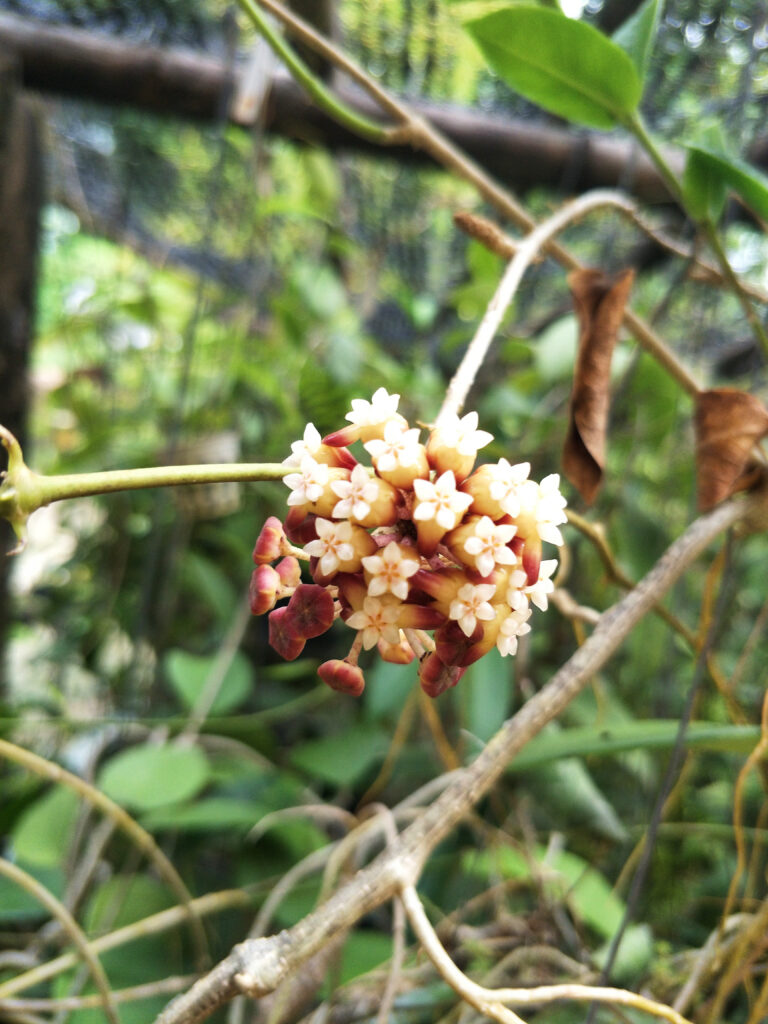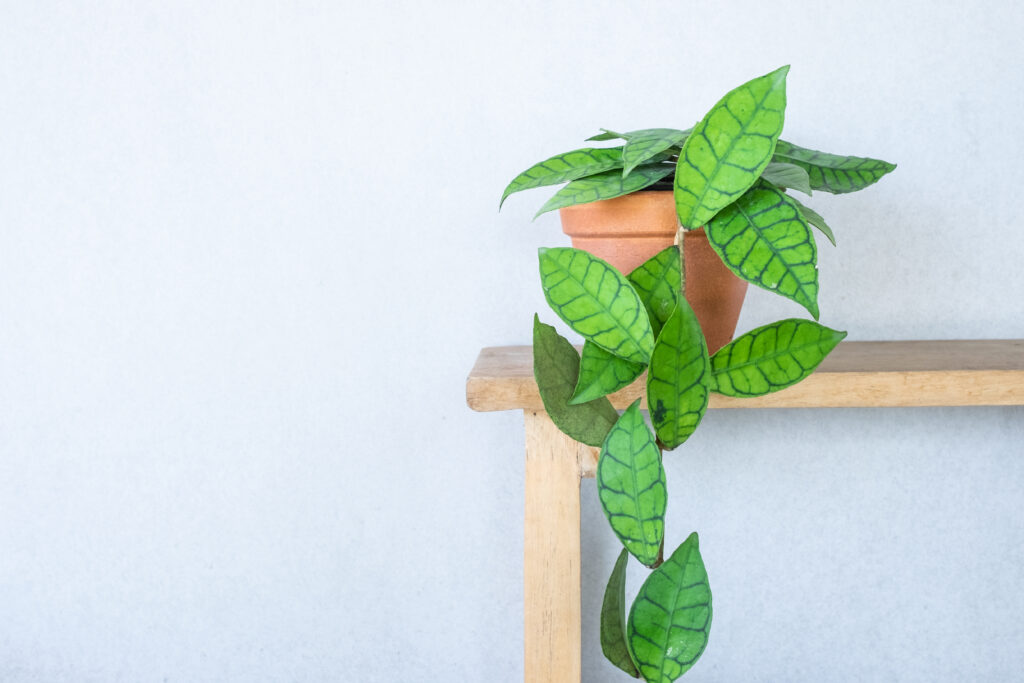If you have ever wandered through the tropical plant section of your local nursery, chances are that you have come across hoya plants. Many of these extremely popular houseplants are common wherever you buy the rest of your plants. Hoya plants are members of the Apocynaceae (dogbane) family. There are over 500 recognized species within the broader hoya genus. Understanding the differences between them all can take some time. So we are going to tackle a few individual hoya species. In this article, we’ll explore the Hoya callistophylla.
| Scientific Name | Hoya callistophylla |
| Common Name(s) | Wax Plant |
| Plant Family | Apocynaceae |
| Native Region(s) | Borneo |
| Life Cycle | Perennial |
| USDA Hardiness Zone | 10-11 |
| Cultivar(s) | Nabuan |
The Hoya callistophylla is a succulent with extremely long vines. Its tendrils can grow between 6 and 12 feet if it has room to stretch its “legs.”
In the article below, we’ll look at some of the other unique attributes of Hoya callistophylla. We will also cover some information about how to care for your stunning hoya.
Hoya callistophylla Leaves
The evergreen leaves are quite large, reaching up to 9 inches long. They are light green, but the dark green veins provide a shocking contrast. Unlike many other hoya plants, it does not have a glossy feel. Instead, the leaves feel almost leathery. They are attached to long, delicate vines.
Hoya callistophylla Flowers
Although hoya flowers are typically fragrant, not all have an overwhelming aroma. Hoya callistophylla is one of the latter. Its flowers have a relatively mild fragrance. They are roughly 1/2 inch in diameter and grow in clusters of 20 to 25 flowers. The lovely blossoms are yellow and red on a white background.
As beautiful as hoya flowers are, they don’t arrive right away. Getting hoya plants to blossom takes a little patience. It may be two or three years before the flowers arrive. But if you care for them properly, your hoya will eventually reward you with a stunning display.

flowers grow in clusters of 20-25 lovely white flowers.
©foolsteams/Shutterstock.com
Fun Facts About Hoya callistophylla
The name for this lovely hoya plant comes from two Greek words meaning “most beautiful leaf.” However, beware. Unfortunately, when ingested, this most beautiful plant is toxic to pets and kids.
Caring for Your Hoya callistophylla
If you have had your eye on hoya plants for a while, consider picking up a Hoya callistophylla. It is one of the hoya species that is relatively easy to care for. That means it is appropriate for beginners in the houseplant world. Additionally, there are few diseases or pests to worry about. So, with proper care, H. callistophylla will survive for many years. Some have even lived for decades! Keep reading to discover a little more details about caring for your hoya.
Water Requirements
Hoyas, including Hoya callistophylla, do not need a lot of water. In the winter, the plants are dormant. So you can allow the soil to dry out completely before watering. But in the summer you should be a little more careful. When the top 2 inches dry out, you can water. Whenever you water your H. callistophylla, add enough to soak the soil without making it soggy.
Add water until you see it seeping out through the drainage holes. Depending on the weather, that is all you need to do for roughly a week, maybe more.
Light Requirements
Hoya callistophylla needs indirect but bright light for no less than six hours every day. If your hoya gets less light than is necessary, it will grow leggy as it seeks sunlight. Ultimately, this will result in less foliage and a weaker plant. Avoid keeping your hoya in direct sunlight to protect the delicate leaves.
However, not all homes or offices have access to enough indirect light. In those cases, grow lights or other artificial lights will work well. Just extend the exposure to around 8 hours or more.
Temperature requirements
This flowering, tropical plant needs adequate humidity and a warm environment. The ideal humidity levels range from 40-60%, and room temperature should be roughly 60-85 degrees Fahrenheit. In most cases, the standard indoor temperature of any home or office is sufficient. But you may need to find a more humid environment for your hoya. For example, some people choose to add their hoya to laundry rooms or bathrooms. However, you can just as easily mist your plants occasionally to boost the humidity in their environment.
Occasional dips in temperature down to around 50 degrees Fahrenheit will not harm your hoya. However, prolonged exposure may damage your plant or stunt its growth. So be sure to avoid leaving them outside in cold weather for extended periods of time.
Propagation and Pruning
As with other hoya plants, the Hoya callistophylla is very easy to propagate. Take a stem cutting and place it in a container with water. After a few days submerged in the water, your hoya cutting will start to establish a new root system. Once the new roots have developed, you can transplant them into the appropriate potting medium.
Pruning your hoya will help keep those lengthy vines in check. If you decide to prune it back, do so in early spring before the flower buds form. Additionally, avoid cutting off any areas that held flowers the year prior. Hoya flowers reappear in the same part of the plant annually, and you don’t want to risk accidentally snipping off a bud.
Growing Requirements
Choosing the right container or pot for your Hoya callistophylla is crucial. Since hoyas don’t have deep roots, they thrive in shallower pots or containers. Find one that will keep the roots snug but not bound together. But avoid containers that are larger than necessary. When there is more soil than the roots need, they won’t soak up enough water. That will lead to a soggy state and root rot.
Another consideration is drainage. Hoyas need pots and potting soil that allow for adequate drainage. Find a container with enough holes and select a loose potting medium. Nutrient-rich mixes, like those meant for cacti and succulents, are ideal. However, you can improve the drainage by adding items like perlite, pumice, and ceramic balls.
Fertilization is not necessary during the winter while your plant is in a dormant state. But in the spring and summer, it is important to provide some food for your lovely H. callistophylla. Select a water-soluble slow-release fertilizer. Alternatively, consider adding a nitrogen-rich fertilizer in the spring to encourage foliage growth. Then switch to a potassium-based option after flower buds begin to form.

plants have spectacular light green leaves offset by dark green veins.
©rattiya lamrod/Shutterstock.com
The photo featured at the top of this post is © rattiya lamrod/Shutterstock.com
FAQs (Frequently Asked Questions)
Do hoyas like to be misted?
Hoyas are tropical plants that need a relatively humid environment. The ideal space is often difficult to maintain in a home or office setting. So some hoya species will thrive when they get misted occasionally. But it is not necessary all the time or with all varieties. Contact your local nursery with questions about a specific species.
Do hoyas prefer to climb or hang?
Even the smallest and most compact hoya plants have lovely vines. Whether you choose to let them climb or hang will depend greatly on the hoya variety you have. Some work better trailing over their baskets. However, others are lovely additions to trellis displays.
Are hoya plants good indoor plants?
Yes, all hoya plants make wonderful indoor houseplants. Many hoya species have long, trailing vines that make them a fantastic addition to hanging pots or containers.
Thank you for reading! Have some feedback for us? Contact the AZ Animals editorial team.






